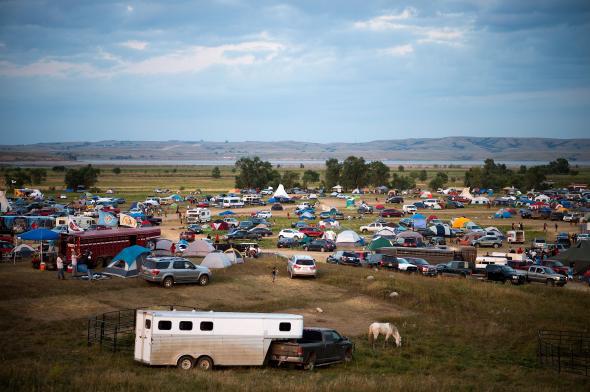North Dakota Gov. Jack Dalrymple on Monday ordered thousands of Native American and environmental activists to leave the federal property on which they’ve been protesting construction of the Dakota Access Pipeline for months. The evacuation order came days after the federal government set a Dec. 5 deadline for the protesters to clear out, but neither state nor federal officials had said how, exactly, they planned to get everyone to comply. It appears we now have the answer: by making them too cold and hungry to stay put. Via Reuters:
North Dakota law enforcement will begin to block supplies from reaching protesters at a camp near the construction site of an oil pipeline project in an effort to force demonstrators to vacate the area, officials said on Tuesday. … Supplies, including food and building materials, will be blocked from entering the main camp…, said Maxine Herr, a spokeswoman from the Morton County Sheriff’s Department. …
The building materials intended for the site are a top priority because the camp is not zoned for permanent structures, Fong said. Propane tanks also will be blocked because they have been used in attacks against law enforcement, she said.
When the U.S. Army Corps of Engineers, which manages the site, first set the deadline they stressed that protesters—who believe the pipeline endangers local indigenous communities and their sacred lands, and more broadly threatens the environment—would not be removed by force. The supply blockade is theoretically a more peaceful way to get protesters to depart as winter approaches, but it remains an open question how authorities would respond if anyone tries to deliver supplies against government orders. While the order went into effect immediately, as of Tuesday morning no cars or trucks carrying supplies had yet been turned back, according to the North Dakota Department of Emergency Services.
If completed, the pipeline would carry 570,000 barrels of Bakken Crude oil per day from the Dakotas to Illinois. But for that to happen, it first needs to cross the Missouri River. Originally, the plan was for the pipeline to cross the river just north of Bismarck, but that route was scrapped over concerns about possible drinking water contamination. The engineers then rerouted the project beneath a lake near the Standing Rock Indian Reservation instead. As Nives Dolsak and Aseem Prakash put it in Slate earlier this month, the message the government is sending is clear: “While the risk of water contamination is not acceptable for Bismarckians, it is OK for the Sioux Indians.”
Elsewhere in Slate:
